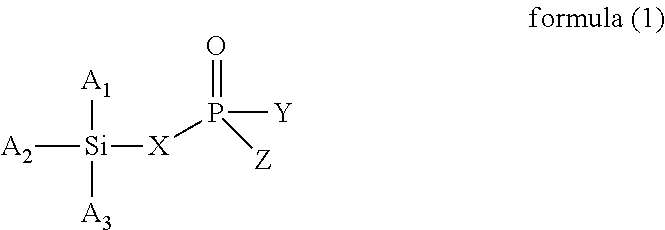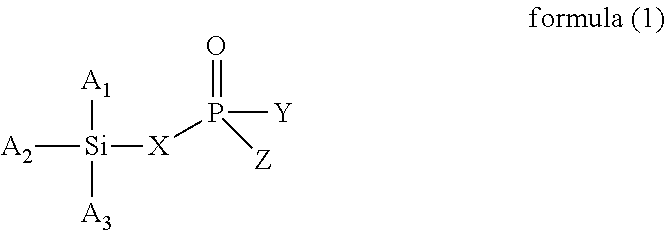Modified rubber containing silicon and phosphorus, composition and manufacturing method thereof
- Summary
- Abstract
- Description
- Claims
- Application Information
AI Technical Summary
Benefits of technology
Problems solved by technology
Method used
Image
Examples
example 1a
[0075]An autoclave reactor was provided with a capacity of 10 liters filled with nitrogen. 5525 g of cyclohexane, 10 g of tetrahydrofuran, 1.66 g of ethylene glycol diethyl ether, 45 g of isoprene, 621 g of 1,3-butadiene, and 200.6 g of styrene were charged into the autoclave reactor. When the temperature of the reactor content reached 30° C., 10.2 g (8.06 mmole) of 5 wt % n-butyl lithium was added to initiate the polymerization reaction. The polymerization reaction was carried out under adiabatic conditions with a maximum temperature of 64° C. When the polymerization reaction was almost completed, 33 g of 1,3-butadiene was added and further polymerization was carried out for about 5 minutes. Then, 7.0 g (21.3 mmole) of diethyl [2-(triethoxysilyl)ethyl]phosphonate (hereinafter referred to as Modifier 1) was added to carry out the reaction for about 20 minutes, and the molar ratio of the modifier / conjugated diene rubber-lithium (the molar ratio of the modifier to the conjugated diene...
example 1b
[0076]An autoclave reactor was provided with a capacity of 10 liters filled with nitrogen. 5525 g of cyclohexane, 10 g of tetrahydrofuran, and 2.1 g of ethylene glycol diethyl ether were charged into the autoclave reactor, and 45 g of isoprene was added. When the temperature of the reactor contents reached 30° C., 9.6 g (7.66 mmole) of 5 wt % n-butyl lithium was added to initiate the polymerization reaction. The polymerization reaction was carried out under adiabatic conditions. 621 g of 1,3-butadiene and 200.6 g of styrene were further added to the autoclave reactor. When the polymerization reaction was almost completed, the maximum temperature is 66° C., and 33 g of 1,3-butadiene was added to carry out further polymerization for about 5 minutes. Then, 1.73 g (5.26 mmole) of Modifier 1 was added to carry out the reaction for about 20 minutes, and the molar ratio of the modifier / conjugated diene rubber-lithium (the molar ratio of the modifier to the conjugated diene rubber containin...
example 2
[0077]An autoclave reactor was provided with a capacity of 10 liters filled with nitrogen. 5525 g of cyclohexane, 10 g of tetrahydrofuran, and 2.1 g of ethylene glycol diethyl ether were charged into the autoclave reactor, and 621 g of 1,3-butadiene and 200.6 g of styrene were added. When the temperature of the reactor contents reached 30° C., 9.6 g (7.66 mmole) of 5 wt % n-butyl lithium was added to initiate the polymerization reaction. The polymerization reaction was carried out under adiabatic conditions with a maximum temperature of 68° C. When the polymerization reaction was almost completed, 33 g of 1,3-butadiene was added and further polymerization was carried out for about 5 minutes. Then, 1.59 g (4.84 mmole) of Modifier 1 was added to carry out the reaction for about 20 minutes, and the molar ratio of the modifier / conjugated diene rubber-lithium (the molar ratio of the modifier to the conjugated diene rubber containing alkali metal ions) was 1.4. Next, methanol was added to...
PUM
| Property | Measurement | Unit |
|---|---|---|
| Fraction | aaaaa | aaaaa |
| Fraction | aaaaa | aaaaa |
| Fraction | aaaaa | aaaaa |
Abstract
Description
Claims
Application Information
 Login to View More
Login to View More - R&D
- Intellectual Property
- Life Sciences
- Materials
- Tech Scout
- Unparalleled Data Quality
- Higher Quality Content
- 60% Fewer Hallucinations
Browse by: Latest US Patents, China's latest patents, Technical Efficacy Thesaurus, Application Domain, Technology Topic, Popular Technical Reports.
© 2025 PatSnap. All rights reserved.Legal|Privacy policy|Modern Slavery Act Transparency Statement|Sitemap|About US| Contact US: help@patsnap.com



